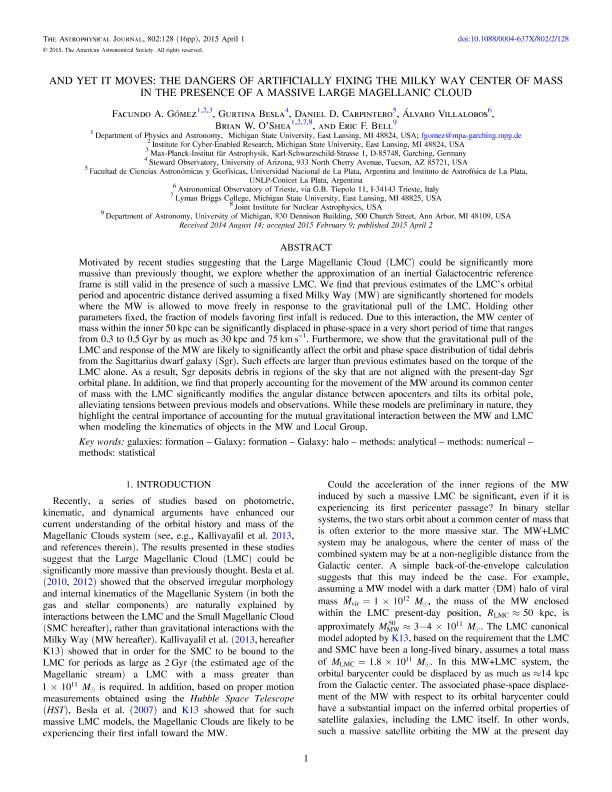Mostrar el registro sencillo del ítem
dc.contributor.author
Gómez, Facundo A.
dc.contributor.author
Besla, Gurtina
dc.contributor.author
Carpintero, Daniel Diego

dc.contributor.author
Villalobos, Álvaro
dc.contributor.author
O’Shea, Brian W.
dc.contributor.author
Bell, Eric F.
dc.date.available
2017-03-13T18:54:57Z
dc.date.issued
2015-04
dc.identifier.citation
Gómez, Facundo A.; Besla, Gurtina; Carpintero, Daniel Diego; Villalobos, Álvaro; O’Shea, Brian W.; et al.; And yet it moves: the dangers of artificially fixing the Milky Way center of mass in the presence of a massive large Magellanic Cloud; Iop Publishing; Astrophysical Journal; 802; 2; 4-2015; 128-144
dc.identifier.issn
0004-637X
dc.identifier.uri
http://hdl.handle.net/11336/13776
dc.description.abstract
Motivated by recent studies suggesting that the Large Magellanic Cloud (LMC) could be significantly more massive than previously thought, we explore whether the approximation of an inertial Galactocentric reference frame is still valid in the presence of such a massive LMC. We find that previous estimates of the LMC?s orbital period and apocentric distance derived assuming a fixed Milky Way (MW) are significantly shortened for models where the MW is allowed to move freely in response to the gravitational pull of the LMC. Holding other parameters fixed, the fraction of models favoring first infall is reduced. Due to this interaction, the MW center of mass within the inner 50 kpc can be significantly displaced in phase-space in a very short period of time that ranges from 0.3 to 0.5 Gyr by as much as 30 kpc and 75 km s−1. Furthermore, we show that the gravitational pull of the LMC and response of the MW are likely to significantly affect the orbit and phase space distribution of tidal debrisfrom the Sagittarius dwarf galaxy (Sgr). Such effects are larger than previous estimates based on the torque of the LMC alone. As a result, Sgr deposits debris in regions of the sky that are not aligned with the present-day Sgr orbital plane. In addition, we find that properly accounting for the movement of the MW around its common center of mass with the LMC significantly modifies the angular distance between apocenters and tilts its orbital pole, alleviating tensions between previous models and observations. While these models are preliminary in nature, they highlight the central importance of accounting for the mutual gravitational interaction between the MW and LMC when modeling the kinematics of objects in the MW and Local Group.
dc.format
application/pdf
dc.language.iso
eng
dc.publisher
Iop Publishing

dc.rights
info:eu-repo/semantics/openAccess
dc.rights.uri
https://creativecommons.org/licenses/by-nc-sa/2.5/ar/
dc.subject
Formation of Galaxies
dc.subject
Galaxy
dc.subject
Halos
dc.subject
Numerical Methods
dc.subject
Statistical Methods
dc.subject.classification
Otras Ciencias Naturales y Exactas

dc.subject.classification
Otras Ciencias Naturales y Exactas

dc.subject.classification
CIENCIAS NATURALES Y EXACTAS

dc.title
And yet it moves: the dangers of artificially fixing the Milky Way center of mass in the presence of a massive large Magellanic Cloud
dc.type
info:eu-repo/semantics/article
dc.type
info:ar-repo/semantics/artículo
dc.type
info:eu-repo/semantics/publishedVersion
dc.date.updated
2017-03-07T15:21:34Z
dc.journal.volume
802
dc.journal.number
2
dc.journal.pagination
128-144
dc.journal.pais
Estados Unidos

dc.journal.ciudad
Londres
dc.description.fil
Fil: Gómez, Facundo A.. Gobierno de la Republica Federal de Alemania. Max Planck Institut Fur Astrophysik; Alemania. Michigan State University; Estados Unidos
dc.description.fil
Fil: Besla, Gurtina. University Of Arizona; Estados Unidos
dc.description.fil
Fil: Carpintero, Daniel Diego. Universidad Nacional de la Plata. Facultad de Ciencias Astronómicas y Geofísicas; Argentina. Consejo Nacional de Investigaciones Científicas y Técnicas. Centro Científico Tecnológico La Plata. Instituto de Astrofísica de La Plata; Argentina
dc.description.fil
Fil: Villalobos, Álvaro. Astronomical Observatory of Trieste; Italia
dc.description.fil
Fil: O’Shea, Brian W.. Michigan State University; Estados Unidos. Joint Institute for Nuclear Astrophysics; Estados Unidos
dc.description.fil
Fil: Bell, Eric F.. University Of Michigan; Estados Unidos
dc.journal.title
Astrophysical Journal

dc.relation.alternativeid
info:eu-repo/semantics/altIdentifier/doi/http://dx.doi.org/10.1088/0004-637X/802/2/128
dc.relation.alternativeid
info:eu-repo/semantics/altIdentifier/url/http://iopscience.iop.org/article/10.1088/0004-637X/802/2/128/meta
Archivos asociados
